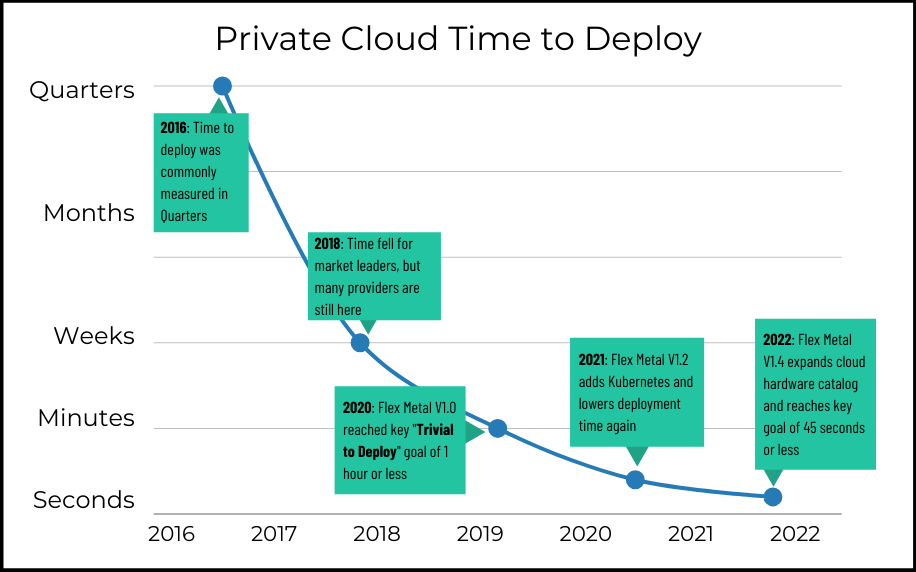
What is Cloud Repatriation?
“Cloud Repatriation” has recently become a buzzword – and one that builds on the confusion of “cloud”. This term is typically used when talking about companies that are significantly overpaying for infrastructure from their public cloud of choice. See our Cloud Cost Tipping Point for more details.
In this blog:
- What is Cloud Repatriation?
- Private Cloud Deployment Times
- Key Study: Cloud Repatriation term versus Workload Repatriation
Cloud Repatriation is when a company is moving workloads out of the Public Clouds to be under the company’s direct responsibility. This is typically used to describe when moving from the “Mega Clouds” (AWS, Azure, GCP, etc.) and is done to reap the cost-savings benefits. What actually happens when a company moves the workload is more accurately called “Workload Repatriation” in most scenarios and thus Cloud Repatriation is often a misnomer.
The advent of Cloud Repatriation as a term may have come from the idea that a company would be forced to not only move the workload but also move it “off the Cloud”. The important distinction here is the “Public Clouds” is not the “Cloud”. The Cloud is a concept of separating hardware management from the usage of resources supplied by that hardware. In years past, it was complex to create your own Cloud, but today many providers have released software or hardware and software combinations that make it trivial to create a Cloud. Our product, OpenMetal Private Cloud, accomplished the Trivial to Deploy moniker in 2020.
Private Cloud Deployment Times
OpenMetal Private Clouds are available in two flavors:
- The “On-Demand Hosted Private Cloud” version (highlighted to the right)
- Blended Cloud and Bare Metal Hybrid Clusters
As we moved more and more workloads to OpenMetal we recognized the need for highly automated bare metal to joined to Clouds to handle workloads better fit for bare metal.

Let’s return to the point that Cloud Repatriation does not require moving away from a Cloud approach to infrastructure. Even if you have determined that your workload is a better fit for non-Cloud approaches, it will often be the case that it is only the primary workload and not secondary supporting infrastructure. For example, you will still want Object Storage in your Cloud for backups, but you might want direct hardware access for your databases without VM or Container overhead. Modern Clouds – by this I mean Private Clouds, Public Clouds, Hybrid Clouds, whatever you want to call them – can handle “bare metal” as well. So run your bare metal workloads on the bare metal inside your Cloud-based infrastructure.
So maybe the origin of this term intended Cloud Repatriation to mean to move your Cloud back under your control? That to me makes sense. Other usages simply confuse the term though, even by critically important findings like the following. Check out this article on Cloud Repatriation Options – Colo vs On-Premise vs Hosted Private Cloud.
Key Study Uses the Cloud Repatriation term versus Workload Repatriation
This term was recently used in an article by Andreessen Horowitz – a16z – called “The Cost of Cloud, a Trillion Dollar Paradox“. In that article (my summary of it at least) the analysts looked at how medium-sized+ companies can find themselves significantly overpaying for infrastructure. So much so that the overall market value of users of the Mega Clouds, particularly companies that have a large COGS from infrastructure, is now depressed by “Trillions”.
In my view, that article has many key findings and will be looked back on in a few years as a catalyst article. To me, it was a call-to-arms by Andreesen Horowitz for mid-tier providers, providers like OpenMetal, to look at the market and decide if we can provide cloud solutions at a significant discount from what the Mega Clouds are charging. We did take up the call, but more on that another time!
To reiterate, when a company moves their workloads out of a Public Cloud it does not mean they move their workloads back to how those workloads were managed before. There is no reason to move to an older infrastructure model as having an in-house Cloud is relatively straightforward nowadays. Did you use Terraform or Ansible to automate the creation of your Cloud infrastructure on AWS, GCP, or Azure? Well, guess what, that same Infrastructure as Code mentality is supported by popular Private Cloud software like OpenMetal Clouds.
Did your Dev team fall in love with Kubernetes? It is pretty awesome, for sure, and guess what, Kubernetes is also standard stock for any modern Cloud.
Many companies have found that skills need to be reintroduced to the company to take on “Cloud Administration”. This may be a concern for you, but the ease of running Clouds has also dramatically advanced in the past 5 years. For self-managed clouds, an experienced system administrator can learn to run Clouds in as little as 40 hours. Relearning hardware is a valid concern, but one that has boundaries and multiple ways to de-risk including onboarding, service contracts, and management options that yield per VM costs that are still well below Mega Cloud costs and can be temporary.
So, in summary, if you are deciding on “Cloud Repatriation” then we encourage you to more properly look at it as a “Workload Repatriation” or to define Cloud Repatriation as just taking ownership of your Cloud again. Please consider either our hosted private cloud or our managed private cloud to accelerate your company’s reclaiming your Cloud.
Test Drive
For eligible organizations, individuals, and Open Source Partners, Private Cloud Cores are free of charge. Qualify today.
Subscribe
Join our community! Subscribe to our newsletter to get the latest company news, product releases, partner updates, and more.




































